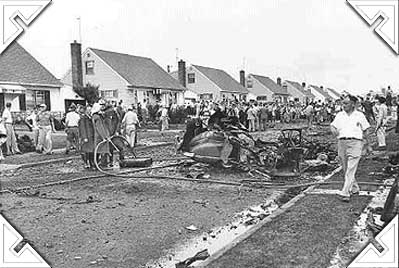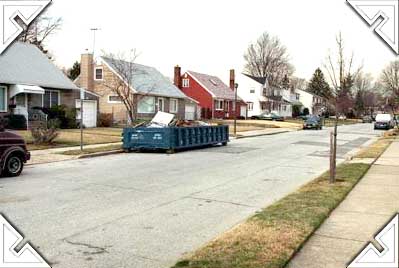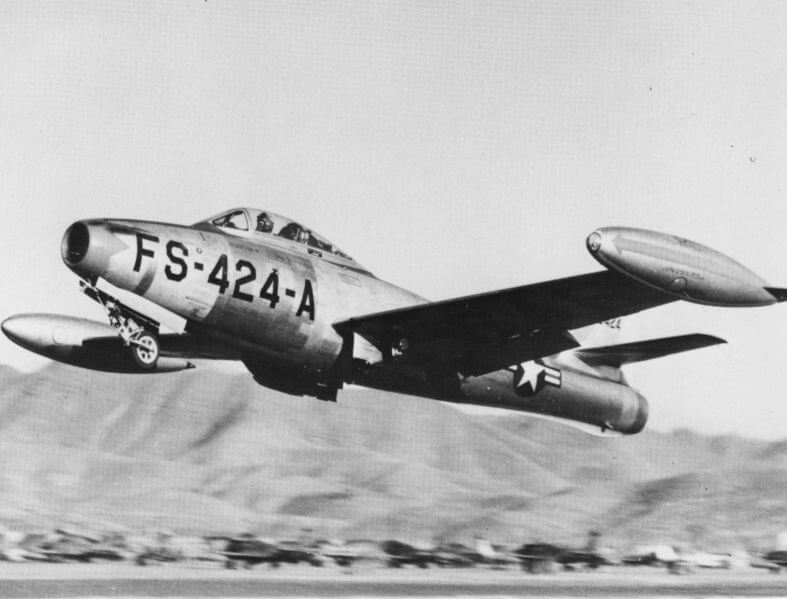August 8, 1954:
Wantagh, New York – Residents of this community paid tribute today to the Air Force pilot who stayed with his disabled jet fighter-bomber to crash it into an almost deserted street at noon last Tuesday.
A memorial service for Captain William Weiland was held at the site of the recently filled crater that had been blasted into Denver Road by the exploding Thunderjet. A fund drive was started to aid his widow and baby daughter who live in Milford, Delaware.
An education fund for 18-month-old Patricia Weiland will be the first goal of the drive. Plans have been made for a memorial plaque to be installed at the Wantagh Post Office.
Three hundred residents and representatives of the Air Force and local groups attended the ceremony. I was conducted by members of the Wantagh Clergy Council, a nonsectarian organization of the community's religious leaders.
The Rev. James E. Boyd, pastor of the Wantagh Memorial COngregational Church, said that “the sacrifice of the pilot deserves sacrifices on our part in aiding the widow and the child.”
Lieutenant Colonel Richard M. Graham, Chaplain of the First Air Force, announced that funeral services would be held at Arlington National Cemetery tomorrow at 2 P.M.
August 9, 1954:
Captain William H. Weiland, the Air Force Pilot who dies when his jet crashed at Wantagh, Long Island, New York, last Tuesday, was buried at Arlington National Cemetery today with full military honors. Participating in the ceremony at 2 p.m. were an honor guard of thirty men, a color detail, a ceremonial band, and firing detail of seven men who discharged three volleys in the Captain's honor. Major Clyde M. Martin, an Air Force Chaplian, conducted the services, which were attented by the Captain's widow, Mrs. Madge Weiland.
During the month of August 1954 a United States Air Force fighter, while traveling from Delaware to Massachusetts, crashed into the middle of the street on Denver Road in Wantagh, New York. The crash and ensuing fire damaged some 30 homes on Denver Road, Dover Road and Roxbury Avenue.
DISASTER AVERTED IN JET CRASH:
The heroic sacrifice of a jet pilot averts disaster for the town of Wantagh, New York. Landing his burning Thunderjet at a wide intersection, the pilot – who died in the crash – avoided a nearby residential area, saving countless lives.
IT HAPPENED HERE
When the Sky Fell in Wantagh
Courtesy of Newsday
Abhout half past noon on August 3, 1954, an Air Force Republic F-84 Thunderjet roared out of a cloudy sky and crashed in the center of Denver Road in Wantagh, New York, a subdivision busy with families and young children. The pilot died in the crash, which sprayed jet fuel and chunks of metal over a wide area. Five people on the ground were injured and one man died of injuries several days later.
William Schick, a retired Grumman employee whose house was damaged, still lives there. He recalls the government made sure insurance money was forthcoming and damage, such as the hole in the street, was repaired quickly. There were plans to put up a plaque, he says, but that never materialized.
Another resident, Richard Massaro, bought his house, one of those damaged in the crash, in 1982. Since most residents, like him, moved in long after the crash, “nobody really talks about it,” Massaro says.
The Republic F-84 Thunderjet was an American-built turbojet fighter-bomber aircraft. Originating as a 1944 United States Air Force proposal for a daytime fighter, the F-84 flew in 1946. Although it entered service in 1947, the Thunderjet was plagued by so many structural and engine problems that a 1948 Air Force review declared it unable to execute any aspect of its intended mission and considered cancelling the program. The aircraft was not considered fully operational until the 1949 F-84D model and the design matured only with the definitive F-84G introduced in 1951. In 1954, the straight-wing Thunderjet was joined by the swept-wing F-84F Thunderstreak fighter and RF-84F Thunderflash photo reconnaissance aircraft.
The Thunderjet became the Air Force's primary strike aircraft during the Korean War, flying 86,408 missions and destroying 60% of all ground targets in the war as well as eight Soviet-built MiG fighters. Over half of the 7,524 F-84s produced served with NATO nations, and it was the first aircraft to fly with the U.S. Air Force Thunderbirds demonstration team. The USAF Strategic Air Command had F-84 Thunderjets in service from 1948 through 1957.
WEILAND, WILLIAM HUBBARD
CAPT 1737 FERRYING SQ DOVER AFB USAF
- DATE OF BIRTH: 09/22/1919
- DATE OF DEATH: 08/03/1954
- BURIED AT: SECTION 7 SITE 9008-4
ARLINGTON NATIONAL CEMETERY
Michael Robert Patterson was born in Arlington and is the son of a former officer of the US Army. So it was no wonder that sooner or later his interests drew him to American history and especially to American military history. Many of his articles can be found on renowned portals like the New York Times, Washingtonpost or Wikipedia.
Reviewed by: Michael Howard



